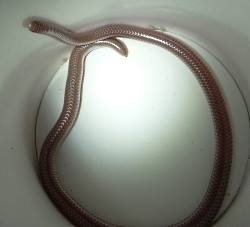
Leptotyphlops humilis
Courtesy & Copyright 2006
John S. Ascher, Photographer
If you’re unfamiliar with blindsnakes, don’t worry; most people haven’t heard of them. The 400 species of these seriously strange serpents are mostly tropical. Two species do occur in the southwestern United States, including western Washington County in Utah. They are small, many no larger than a shoelace, and have smooth scales and small eyes.
Blindsnakes typically live underground in loose, moist soil, so you are most likely to find one when gardening. If you do, don’t be alarmed – these tiny snakes are harmless and beneficial. Look closely, or you might mistake one for a worm due to its pinkish color. A black light can be used to tell the difference, as Utah blindsnakes glow fluorescent like scorpions. Blindsnakes eat ants, termites, centipedes and spiders. They can help control populations of these invertebrate pests around your home.
Their jaw architecture is unique. The jaws work like tiny scoops to shovel the larvae and pupae of ants and termites into their mouths. Unlike most snakes, who only eat once every few weeks, blindsnakes consume huge numbers of prey items very quickly. One Australian Blackish Blindsnake was seen to ingest over 1,400 ant larvae without pause!
Biologist in Texas report that screech owls sometimes carry live blindsnakes to their nests. Up to fifteen live among the chicks. Nests with blindsnakes have fewer mites, insects and spiders. Owlets in these nests survived and grew faster than owlets from nests without blindsnakes. This amazing mutualism may have evolved long ago. At over 100 million years old, blindsnakes are the oldest living group of snakes. Although considered primitive, blindsnakes are incredibly successful, if secretive, members of our modern serpent fauna.
Today’s program was written by Andrew Durso of Utah State University’s biology department.
Our theme music was composed by Don Anderson and is performed by Leaping Lulu.
Credits:
Images: Courtesy & Copyright 2006 John S. Ascher, Photographer
Text: Andrew Durso, https://www.biology.usu.edu/htm/our-people/graduate-students?memberID=6753
Additional Reading:
Screech Owls and Blindsnakes: An Unlikely Mutualism, Life is Short, But Snakes are Long, A blog about snake natural history and herpetology research, Andrew Durso, February 28, 2013, https://snakesarelong.blogspot.com/2013_02_01_archive.html
Western Blind Snake (Leptotyphlops humilis), Red Cliffs Desert Reserve, Washington County HCP Administration, https://www.redcliffsdesertreserve.com/western-blind-snake
Feeding Mechanisms of Blindsnakes, Mandibular raking in Leptotyphlopidae, Video Clips, The Kley Lab, Department of Anatomical Sciences, Stony Brook University, The State University of New York, https://renaissance.stonybrookmedicine.edu/anatomy/people/facultypage/kley/videos
